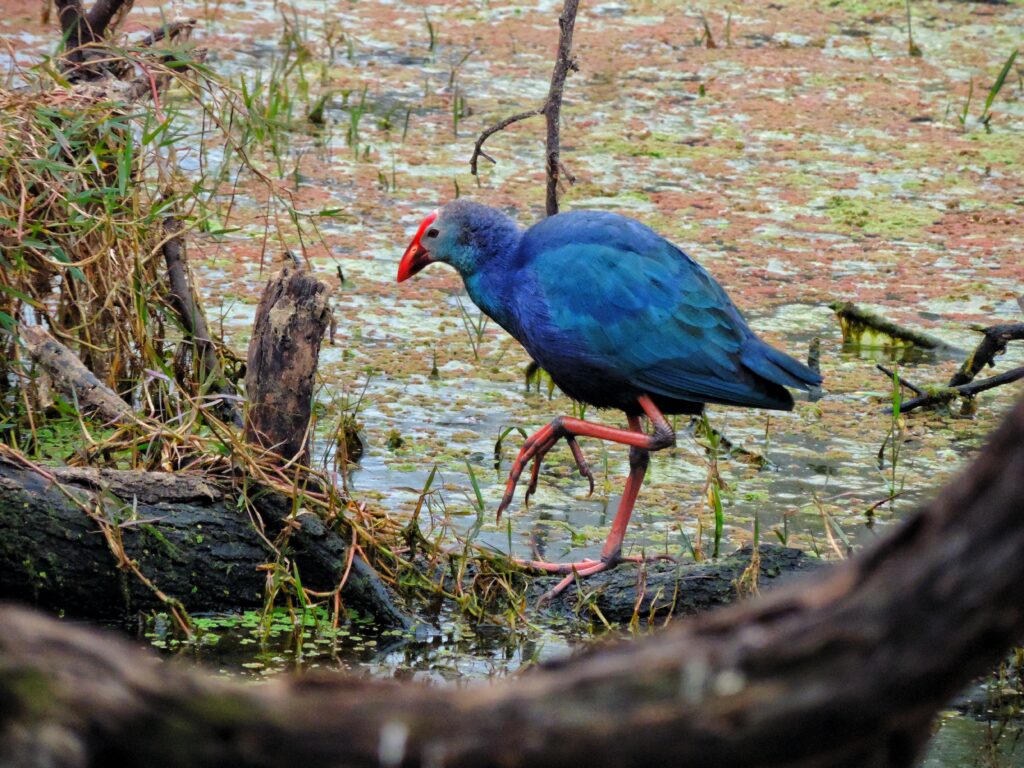Nestled in the heart of Rajasthan, India, the Bharatpur Bird Sanctuary, also known as Keoladeo National Park, is a UNESCO World Heritage Site and a haven for bird enthusiasts. Among its diverse avian population, the Purple Swamphen (Porphyrio porphyrio) stands out as a striking and fascinating species. If you’ve recently clicked a picture of this vibrant bird during your visit, you’ve captured a moment with one of nature’s most colorful and intriguing creatures. Let’s dive into the world of the Purple Swamphen, its habitat, behavior, and why Bharatpur is the perfect place to witness this bird in all its glory.

The Purple Swamphen: A Vibrant Avian Wonder
The Purple Swamphen, also known as the Purple Moorhen, is a large, colorful bird belonging to the rail family, Rallidae. Its scientific name, Porphyrio porphyrio, derives from the Latin word for “purple,” a fitting tribute to its stunning plumage. This bird is easily recognizable by its deep *purple-blue feathers, **bright red beak and frontal shield, and *long, slender legs. Its captivating look makes it a top choice for birdwatchers and photographers.
The Purple Swamphen is widely distributed across Europe, Africa, Asia, and Australasia, with several subspecies adapted to different regions. In India, it is commonly found in wetlands, marshes, and lakes, making Bharatpur Bird Sanctuary an ideal habitat.
Why Bharatpur Bird Sanctuary is Perfect for Spotting the Purple Swamphen
Bharatpur Bird Sanctuary is a wetland ecosystem that provides the perfect environment for the Purple Swamphen. The sanctuary’s shallow lakes, reed beds, and marshes offer abundant food and shelter for these birds. Here’s why Bharatpur is a hotspot for spotting the Purple Swamphen:
1. Rich Biodiversity The sanctuary is home to over 370 bird species, making it one of the most biodiverse birding destinations in the world. The Purple Swamphen thrives in this environment, often seen wading through the wetlands or foraging in the reeds.
2. Year-Round Habitat Unlike migratory birds that visit Bharatpur seasonally, the Purple Swamphen is a resident species. This means you can spot it throughout the year, though the winter months (November to February) are particularly rewarding due to the influx of migratory birds.
3. Photography Opportunities The sanctuary’s well-maintained trails and watchtowers provide excellent vantage points for photographing the Purple Swamphen in its natural habitat. Its vibrant colors contrast beautifully with the greenery of the wetlands, creating stunning visuals.
Behavior and Characteristics of the Purple Swamphen
The Purple Swamphen is not just a pretty bird; it’s also known for its interesting behavior and adaptations. Here are some key characteristics:
1. Diet and Foraging The Purple Swamphen is an omnivore, feeding on a variety of plant matter, insects, small fish, and even eggs of other birds. It uses its long toes to grasp and manipulate food, often seen plucking aquatic plants or probing the mud for invertebrates.
2. Social Structure These birds are highly social and often found in small groups. They communicate through a range of vocalizations, including loud calls and grunts, especially during the breeding season.
3. Breeding and Nesting The Purple Swamphen builds its nest in dense vegetation near water. Both parents participate in incubating the eggs and raising the chicks, which are precocial and can leave the nest shortly after hatching.
4. Adaptability The Purple Swamphen is highly adaptable and can thrive in both natural and man-made wetlands. This adaptability has helped it maintain stable populations despite habitat loss in some regions.
Best Time to Visit Bharatpur for Birdwatching
If you’re planning a trip to Bharatpur Bird Sanctuary to see the Purple Swamphen and other avian wonders, timing is key. Here’s a seasonal breakdown:
Winter (November to February) This is the peak birdwatching season, as migratory birds from Siberia, Europe, and Central Asia flock to the sanctuary. The weather is pleasant, and the wetlands are teeming with activity.
Summer (March to June) While the heat can be intense, summer is a great time to spot resident birds like the Purple Swamphen. The ideal times for birdwatching are early morning and late afternoon.
Monsoon (July to September) The sanctuary receives heavy rainfall during this period, which rejuvenates the wetlands and attracts a variety of waterbi

Photography Tips for Capturing the Purple Swamphen
If you’ve already clicked a picture of the Purple Swamphen, you know how rewarding it is to capture its vibrant colors and unique behavior. Here are some tips to enhance your bird photography skills:
1. Use a Telephoto Lens A lens with a focal length of 300mm or more will help you capture detailed shots without disturbing the bird.
2. Focus on the Eyes The eyes are the most expressive part of any bird. Ensure they are in sharp focus to create a compelling image.
3. Capture Behavior Photograph the Purple Swamphen while it’s foraging, preening, or interacting with other birds. These action shots tell a story and make your images more engaging.
4. Mind the Background A clean, uncluttered background will make your subject stand out. Use a wide aperture to blur the background and draw attention to the bird.
Conclusion
The Purple Swamphen is a true gem of Bharatpur Bird Sanctuary, captivating visitors with its vibrant colors and fascinating behavior. Whether you’re a seasoned birdwatcher or a casual nature lover, spotting this bird in its natural habitat is an unforgettable experience. With its rich biodiversity, stunning landscapes, and excellent birdwatching opportunities, Bharatpur is a must-visit destination for anyone passionate about wildlife and photography.
So, the next time you visit Bharatpur Bird Sanctuary, keep your camera ready and your eyes peeled for the majestic Purple Swamphen. It’s not just a bird; it’s a symbol of the beauty and resilience of nature. Happy birding!


